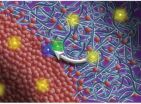(Press-News.org) This press release is available in Spanish.
First detected in the United States a decade ago, the brown marmorated stink bug (BMSB) is now in at least 39 states, is wreaking havoc in homes and gardens, and is a major economic threat to orchard fruits, garden vegetables and row crops. It's no wonder the U.S. Department of Agriculture (USDA) ranks this pest as its top "invasive insect of interest."
But help may be on the way: USDA scientists at the Agricultural Research Service (ARS) Invasive Insect Biocontrol and Behavior Laboratory in Beltsville, Md., are searching for ways to control the stink bug by deciphering its genetic toolkit, studying the pheromones it releases, and evaluating potential attractants for use in commercial traps. ARS is the USDA's principal intramural scientific research agency, and this research supports the USDA priority of promoting international food security.
ARS chemist Ashot Khrimian at the Beltsville lab led a team that identified an "aggregation pheromone" that shows promise as an early-season attractant. The pheromone, released by male stink bugs when they feed, attracts males, females and nymphs (the immature form of the stink bugs) to feeding sites. When mixed with other structurally related chemicals called stereoisomers, the pheromone is relatively simple to synthesize.
Khrimian and Aijun Zhang, an ARS chemist at Beltsville, are completing the identification of exact stereoisomers that the stink bugs are releasing to attract other stink bugs. The mixture and its components also were evaluated by ARS researchers who set up field traps at different sites and with the different candidate formulas, and then counted the numbers of stink bugs they attracted. Data from those field trials, conducted in the summer of 2012, will be added to a previously filed provisional patent application.
Dawn Gundersen-Rindal, the Beltsville lab's research leader, is also looking for genes that might make the stink bug vulnerable to biopesticides or specific treatments that won't harm beneficial insects. In a separate effort, she is working with scientists at Baylor College of Medicine in Houston, Texas, to sequence the stink bug's genome. Sequencing the genome will tell scientists about genes critical to the stink bug's survival and may give them new ways to control the pest.
###
Read more about this research in the January 2013 issue of Agricultural Research magazine.
http://www.ars.usda.gov/is/AR/archive/jan13/stinkbug0113.htm
USDA is an equal opportunity provider and employer. To file a complaint of discrimination, write: USDA, Office of the Assistant Secretary for Civil Rights, Office of Adjudication, 1400 Independence Ave., SW, Washington, DC 20250-9410 or call (866) 632-9992 (Toll-free Customer Service), (800) 877-8339 (Local or Federal relay), (866) 377-8642 (Relay voice users).
Combating USDA's top-ranked invasive insect
2013-01-07
ELSE PRESS RELEASES FROM THIS DATE:
Study provides guidance for use of acid-suppressive medications in hospital patients
2013-01-07
BOSTON -- Critically ill patients in hospital intensive care units (ICUs) are routinely prescribed acid-suppressive medications to reduce their risk of developing stress ulcers and gastrointestinal bleeding, both of which can result from being in a stressful environment and from being intubated. Over the years, this routine practice has often been extended to patients outside the ICU, despite a lack of evidence that this population is at significant risk of these complications.
Now a study led by investigators at Beth Israel Deaconess Medical Center (BIDMC) describes ...
Psychological common ground could ease tensions among those with different religious beliefs
2013-01-07
Understanding how thoughts of mortality influence individuals' beliefs sheds light on the commonalities among different groups' motivations and could help ease tensions between opposing viewpoints, according to University of Missouri experiments that tested the relationship between awareness of death and belief in a higher power. The study found that thoughts of death increased atheists, Christians, Muslims and agnostics conviction in their own world views. For example, contrary to the wartime aphorism that there are no atheists in foxholes, thoughts of death did not cause ...
Cognitive deficits from concussions still present after 2 months
2013-01-07
EUGENE, Ore. -- (Jan. 7, 2013) -- The ability to focus and switch tasks readily amid distractions was compromised for up to two months following brain concussions suffered by high school athletes, according to a study at the University of Oregon.
Research team members, in an interview, said the discovery suggests that some athletes may need longer recovery periods than current practices dictate to lower the risk of subsequent concussions. Conventional wisdom, said lead author David Howell, a graduate student in the UO Department of Human Physiology, has typical recovery ...
Detrimental effect of obesity on lesions associated with Alzheimer's disease
2013-01-07
In France, more than 860,000 people suffer from Alzheimer's disease and related disorders, making them the largest cause of age-related loss of intellectual function. Cognitive impairments observed in Alzheimer's disease result from the accumulation of abnormal tau proteins in nerve cells undergoing degeneration . We know that obesity, a major risk factor in the development of insulin resistance and type 2 diabetes, increases the risk of dementia during the aging process. However, the effects of obesity on 'Taupathies' (i.e. tau protein-related disorders), including Alzheimer's ...
Penn study shows mountains are only minor contributors to erosion and climate regulation
2013-01-07
PHILADELPHIA — Though churning smokestacks, cud-chewing cows and gasoline-burning vehicles are contributing constantly to greenhouse gas emissions, there are also many processes that do the reverse, pulling molecules like carbon dioxide out of the atmosphere. One of these is chemical weathering, which occurs when rock turns into soil. Carbon dioxide molecules and rain combine to dissolve rock, and the weathering products, including sediment, eventually make their way through waterways to the ocean where some become trapped on the ocean bottom and in coral reefs and seashells.
For ...
A French nuclear exit?
2013-01-07
Los Angeles, CA (January 07, 2013). France has been held up, worldwide, as the forerunner in using nuclear fission to produce electricity. However, a third of the nation's nuclear reactors will need replacing in the next decade, and public opinion has shifted toward reducing reliance on nuclear power. In a special issue of the Bulletin of the Atomic Scientists, published by SAGE four articles explore whether France has the means or desire to unplug from nuclear power.
Nuclear arms experts Patrice Bouveret, Bruno Barrillot, and Dominique Lalanne argue that phasing out ...
Timely reminders boost childhood immunizations rates
2013-01-07
AURORA, Colo. (Jan. 7, 2013) – New research from the Children's Outcomes Research Program at Children's Hospital Colorado shows that timely reminders by state or local health departments are more effective at increasing immunization rates among preschool children than those from primary care practices.
The study, published December 13 in the American Journal of Public Health, underscores the importance of partnerships between state and county health departments and primary care practices to keep children up-to-date on recommended vaccines.
"Immunizations provide ...
Racial essentialism reduces creative thinking, makes people more closed-minded
2013-01-07
New research suggests that racial stereotypes and creativity have more in common than we might think.
In an article published in Psychological Science, a journal of the Association for Psychological Science, researcher Carmit Tadmor of Tel Aviv University and colleagues find that racial stereotyping and creative stagnation share a common mechanism: categorical thinking.
"Although these two concepts concern very different outcomes, they both occur when people fixate on existing category information and conventional mindsets," Tadmor and her colleagues write.
The researchers ...
New path to more efficient organic solar cells uncovered at Berkeley Lab's advanced light source
2013-01-07
Why are efficient and affordable solar cells so highly coveted? Volume. The amount of solar energy lighting up Earth's land mass every year is nearly 3,000 times the total amount of annual human energy use. But to compete with energy from fossil fuels, photovoltaic devices must convert sunlight to electricity with a certain measure of efficiency. For polymer-based organic photovoltaic cells, which are far less expensive to manufacture than silicon-based solar cells, scientists have long believed that the key to high efficiencies rests in the purity of the polymer/organic ...
How the kilogram has put on weight
2013-01-07
Post-Christmas and most of us are feeling the over-indulgence. But take heart - experts at Newcastle University, UK, have shown even the kilogram itself has put on weight. Using a state-of-the-art Theta-probe XPS machine – the only one of its kind in the world – the team have shown the original kilogram is likely to be tens of micrograms heavier than it was when the first standard was set in 1875.
And they say a suntan could be the key to helping it lose weight.
The original kilogram – known as the International Prototype Kilogram or the IPK – is the standard against ...

